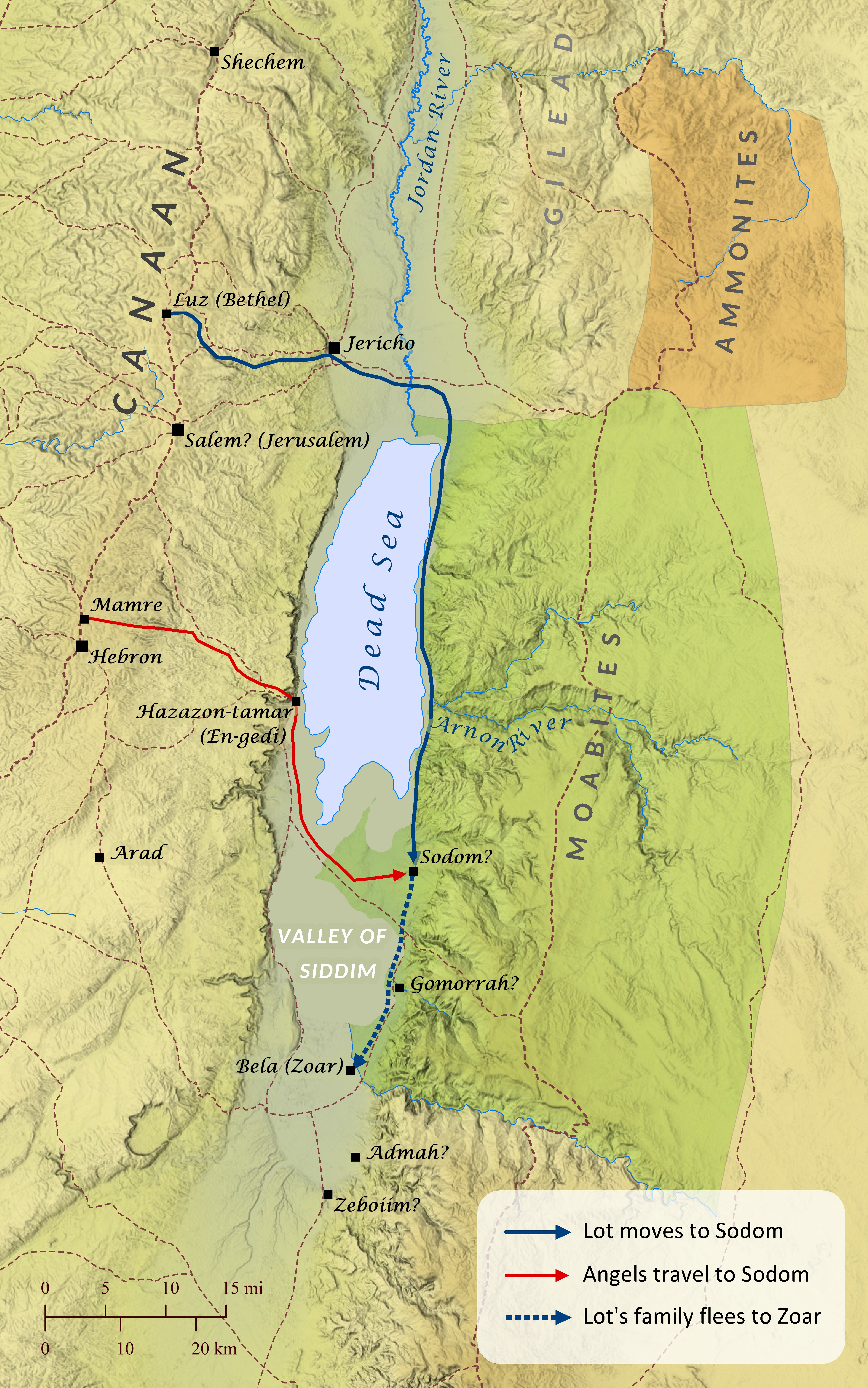
Sodom and Gomorrah Are Destroyed
Genesis 18-19
Author’s note: This article assumes that Sodom, Gomorrah, and Bela (Zoar) were located at Bab edh-Dhra, Numeira, and Khirbat ash-Sheikh `Isa, respectively. The exact locations of the cities of the plain are widely debated, with the primary dispute centering around whether the cities are to be found in the northern area of the Dead Sea (since Lot headed east from Bethel [Genesis 13]) or the southern area (as the Medeba Map shows). It is beyond the scope of this article to present all the evidence to support a southern location, but many of them are well summarized here: “The Discovery of the Sin Cities of Sodom and Gomorrah.” In addition, Eusebius in his Onomasticon describes the Dead Sea as lying between Jericho and Zoar. This author has also recently found that Eusebius notes that Nebereim (Nimrim; see Isaiah 15:6 and Jeremiah 48:34) is located at a village called Bennamareim (likely the site of Gomorrah on this map), which he also says is north of Zoar. Thus, if Eusebius is correct, Zoar is clearly located in the southern area of the Dead Sea, which fits very well with the location shown on this map. Also, Lot’s relocation to Sodom after moving east to the plain of the Jordan suggests that Sodom was located on the east side of the Dead Sea.
The famous cities of Sodom and Gomorrah are first mentioned in Genesis 10:19 in a description of the territory of the Canaanites. The cities are mentioned again in chapter 13, which notes that while Abraham (then called Abram) was living near Bethel (also called Luz), tension began to grow between Abraham’s herders and the herders working for Abraham’s nephew Lot. To resolve the problem, Abraham suggested that he and Lot permanently part ways, and he offered Lot first choice of where to live. Lot chose to move east to the plain of the Jordan, because the land was well watered, and he eventually settled in the city of Sodom. Genesis 14 then describes how Lot was captured by four Mesopotamian kings as they attacked the cities of the plain, but Abraham rescued Lot. Sometime after this Abraham moved to the oaks of Mamre, near Hebron, and three visitors (one of whom is later called “the Lord,” and the other two “angels”) approached his tent. Abraham invited them to share a meal with him and then later accompanied them for the first part of their journey. Along the way the visitors revealed to Abraham that they were going to Sodom to destroy it for its wickedness. Abraham appealed to the Lord to spare the city if even a few righteous lived there, and the Lord agreed and went his way. The two angels arrived at Sodom in the evening (Genesis 19:1), presumably the same day they left, although perhaps they actually took more than one day to travel to Sodom, because the distance from Mamre to Sodom is over 35 miles (56 km), and Scripture does not specifically note that it was the same day. The events that followed that evening are well known, and in the morning the angels compelled Lot and his family to flee the city before it was destroyed. The angels instructed them to flee to the hills, but Lot convinced them to allow him to take refuge in a small village on the plain and not destroy it. Genesis 19:23 seems to suggest that it took Lot’s family a full day and night to reach Zoar, which fits well with the 16 mile (25 km) distance from Sodom to Zoar. As they were reaching Zoar, the Lord rained down fire and burning sulfur on Sodom, Gomorrah, Admah, and Zeboiim, completely destroying them. As Lot’s family was still fleeing, Lot’s wife looked back and turned into a pillar of salt. That same morning Abraham got up and went to where he had last spoken with the visitors, and when he looked out across the plain he saw columns of smoke rising from the destroyed cities. Later Lot and his daughters moved into the hills and lived in a cave, because they were afraid to remain in Zoar. Fearing they would never marry, Lot’s daughters both got their father drunk and conceived children by him, though he was unaware of it. These children became ancestors of the Moabites and the Ammonites.